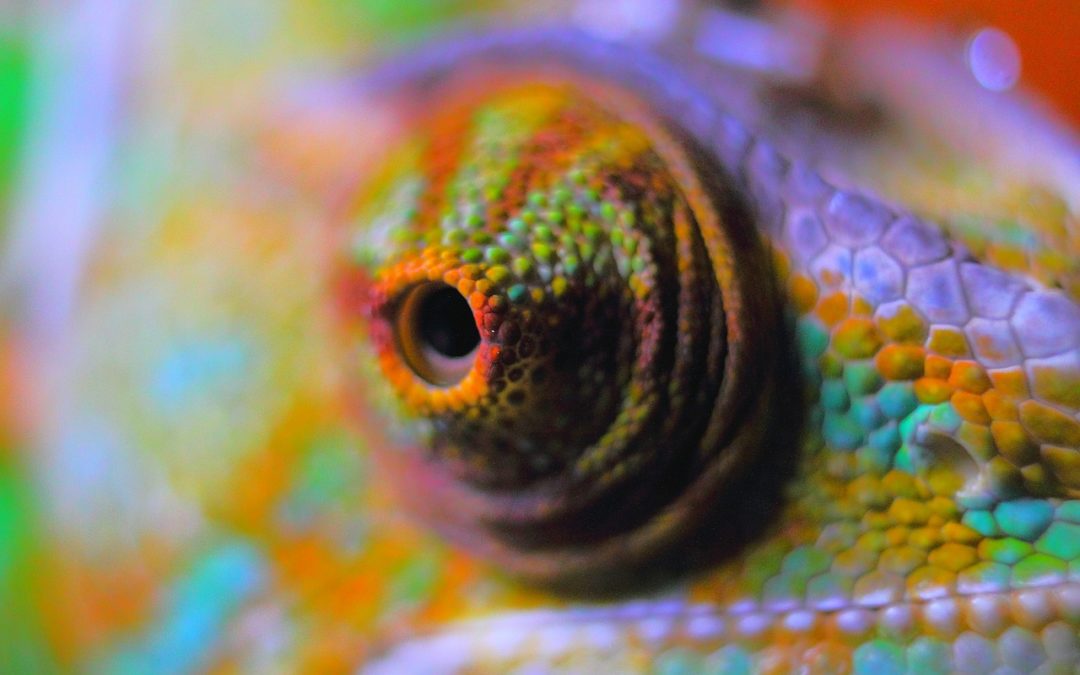Aside from the ability to change colors at will and a great skill at camouflage and prey deception, chameleons also have one of the most amazing set of eyes among lizards and reptilians. The chameleon is considered to be among the most highly vision-oriented lizards, using their acute and highly developed sense of sight to capture prey, for mate identification and selection, and for surrounding awareness and avoiding predators. Biologists have discovered several of the unique features of chameleon vision. Their eyes have negative lenses, positive corneas, monocular focusing and laterally protruding eyes that move independently of each other.
Scientists theorize that the development of the chameleon visual system may have evolved in order to help chameleons in capturing prey and/or avoid predators. Their protruding eyes give their field of vision greater angle, or amplitude and their eye movement is wider than most known vertebrates. Another benefit of laterally protruding eyes is panoramic sight, wherein chameleons can see wider scenes using their two eyes as compared to vertebrates. This feature, combined with eyes that move independently of each other, also gives the chameleon almost 360 degrees of vision. This allows these critters to watch an approaching object while simultaneously scanning the rest of its surroundings. A chameleon eye is protected by an eyelid that is fused to the pupil.
Another feature of chameleon eyes is the negative lens. It means that the lenses in their eyes are concave or curving inwards. This increases retinal image size, which allows high precision and range of vision. In a scaled comparison with the eyes of all other vertebrates, the image magnification in chameleon eyes is amazingly higher.
The positive or convex (curving outwards) cornea is another useful and unusual feature of chameleon eyes. As mentioned earlier, the lens is negative; the cornea of chameleon eyes is positive or convex. This feature of a powerful cornea contributes to a precision in focusing that is considerably better than other vertebrates. This feature is aptly adapted into the chameleon eyes to improve sight resolution in a narrow field of vision.
Monocular focusing in chameleon eyes arises from the combination of a negative lens and a positive cornea in the chameleon eye allow for accurate focusing by corneal accommodation or the response of the lens of eye when focusing on a near object and then a distant object of vice versa. The ability of independent focus and movement of each makes monocular focusing a unique trait of chameleons. Although each eye moves independently, they coordinate with each other once a single eye has a fixed focus on a prey. By shifting from monocular to binocular focusing, the chameleon further augments it focus and precision in targeting its prey.
Finally, striated (overlapping stripes) rather than smooth ciliary muscle (ring of muscle in the eye’s middle layer) in chameleons and other reptiles allows for rapid focusing.
With these extraordinary eye features, the chameleon can be considered a formidable predator in its own right. Being able to move their eyes around to nearly 360 degrees, the necessity for head movement when focusing is eliminated and thus drastically lessening the chance of prey detecting the presence of a stalking chameleon. Nature indeed has ingenious ways of designing creatures and their mode of survival.


Recent Comments